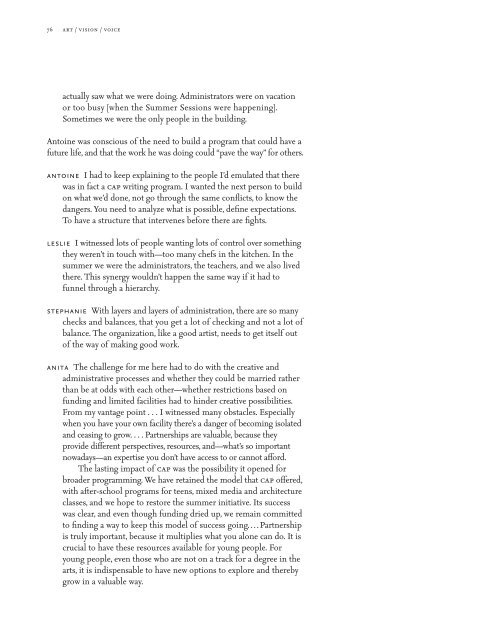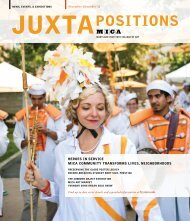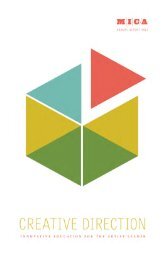art/vision/voice - Maryland Institute College of Art
art/vision/voice - Maryland Institute College of Art
art/vision/voice - Maryland Institute College of Art
Create successful ePaper yourself
Turn your PDF publications into a flip-book with our unique Google optimized e-Paper software.
76 <strong>art</strong> / <strong>vision</strong> / <strong>voice</strong><br />
actually saw what we were doing. Administrators were on vacation<br />
or too busy [when the Summer Sessions were happening].<br />
Sometimes we were the only people in the building.<br />
Antoine was conscious <strong>of</strong> the need to build a program that could have a<br />
future life, and that the work he was doing could “pave the way” for others.<br />
antoine I had to keep explaining to the people I’d emulated that there<br />
was in fact a cap writing program. I wanted the next person to build<br />
on what we’d done, not go through the same conflicts, to know the<br />
dangers. You need to analyze what is possible, define expectations.<br />
To have a structure that intervenes before there are fights.<br />
leslie I witnessed lots <strong>of</strong> people wanting lots <strong>of</strong> control over something<br />
they weren’t in touch with—too many chefs in the kitchen. In the<br />
summer we were the administrators, the teachers, and we also lived<br />
there. This synergy wouldn’t happen the same way if it had to<br />
funnel through a hierarchy.<br />
stephanie With layers and layers <strong>of</strong> administration, there are so many<br />
checks and balances, that you get a lot <strong>of</strong> checking and not a lot <strong>of</strong><br />
balance. The organization, like a good <strong>art</strong>ist, needs to get itself out<br />
<strong>of</strong> the way <strong>of</strong> making good work.<br />
anita The challenge for me here had to do with the creative and<br />
administrative processes and whether they could be married rather<br />
than be at odds with each other—whether restrictions based on<br />
funding and limited facilities had to hinder creative possibilities.<br />
From my vantage point . . . I witnessed many obstacles. Especially<br />
when you have your own facility there’s a danger <strong>of</strong> becoming isolated<br />
and ceasing to grow. . . . P<strong>art</strong>nerships are valuable, because they<br />
provide different perspectives, resources, and—what’s so important<br />
nowadays—an expertise you don’t have access to or cannot afford.<br />
The lasting impact <strong>of</strong> cap was the possibility it opened for<br />
broader programming. We have retained the model that cap <strong>of</strong>fered,<br />
with after-school programs for teens, mixed media and architecture<br />
classes, and we hope to restore the summer initiative. Its success<br />
was clear, and even though funding dried up, we remain committed<br />
to finding a way to keep this model <strong>of</strong> success going. . . . P<strong>art</strong>nership<br />
is truly important, because it multiplies what you alone can do. It is<br />
crucial to have these resources available for young people. For<br />
young people, even those who are not on a track for a degree in the<br />
<strong>art</strong>s, it is indispensable to have new options to explore and thereby<br />
grow in a valuable way.
















